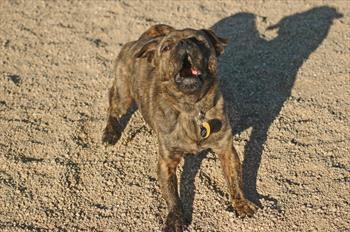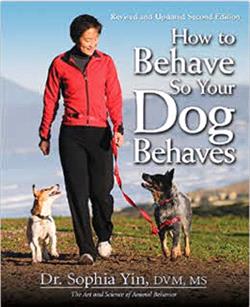A reader once asked, “How can a dog bark for such great lengths of time? If I holler and scream for a long time, I lose my voice.”
The answer, of course, is practice. And it starts when they’re young.
Take, for instance, Alf the Aussie, who lives down the street. He started out at the front window, barking sharply at passersby: “Stay away from my property. Just move it on by.” He was so successful at sending the mail carrier and other pedestrians scurrying that when his owner promoted him to the front yard, he increased his alarm duties, working overtime.
Or Lily the Labrador retriever, who barks outside at night. She started with short bursts but now cranks it out continuously.
So how do you break a horrific barking habit before your pooch is up to epic nighttime arias? The simplest solution is to keep dogs inside if they bark only when they’re out, and to increase their exercise if they’re bored. Instead, many people reach for a behavioral band-aid such as citronella or an electronic anti-bark collar. Both can work wonders initially, but often the great response is short-lived. Furthermore they will do nothing for a serious underlying problem such as separation anxiety. Additionally, many savvy barkers learn to outsmart the devices.
That’s what Kaya, an 8-month-old pony-size Anatolian shepherd puppy, did. Bred for generations to guard livestock by being calm enough to bond well with the woolly flock but alert and loud enough to chase potential predators off with their booming barks, Anatolians are now often discarded for the very talents that earned them their name. Kaya was proving true to her breed.
“She barks in the yard from 4 pm through the evening when I’m home, and then, when I bring her inside, she runs around anxiously and continues randomly barking throughout the night,” explained Kaya’s owner, Ashley. “I take her on long walks twice a day and then keep her in the yard because she really enjoys being outdoors, but she can bark for hours after she sees a passing car or jogger, or a deer in the distance.”
I surveyed the moderate hillside yard with its expansive green fields, soft dirt road and quiet while Kaya sprawled peacefully at Ashley’s feet.
“I tried yelling first, but it didn’t work,” Ashley explained. “She barks anyway.”
No surprise here. Like the grade-school prankster who shoots spitballs at classmates to elicit a fiery verbal reply, dogs often hurl howls and toss yaps until they get some sort of human response, and humans frequently fall into this time-honored trap: They rush out when Rover’s barking and rattle off loud commands.
This quiets Rover temporarily as he savors his success, but soon after the master goes back inside, he starts up, hoping for another reward. Then, as if reading from a manual on how to teach your dog to bark for attention, the owner gradually extends the amount of barking it takes before she’ll race to hush her hound. Pretty soon, Rover knows he has to bark longer than a Wagner opera to get the attention he deserves.
A smart owner will figure this game out, ignore the barking until it stops and then reward Rover immediately with food and praise for being quiet. Once Rover gets the idea that silence leads to success, the owner will then build up the amount of quiet that earns Rover the reward. Ashley had tried the first part of this plan.
“She knows the word ‘quiet’ and responds to it,” said Ashley, “but she starts barking a couple of minutes later.”
Clearly, Kaya didn’t know that “quiet” meant “quiet all day.”
“And when she sees a deer or a car, she just ignores the command,” Ashley added.
Has she tried anything else? “Well, I’m pretty sure the kennel I boarded Kaya at used a citronella collar,” Ashley replied, “because she came back barking sideways.”
Hmm. My first impression was that Kaya was the sort whose brain works a second or two behind her lumbering body. But maybe I was wrong. When a dog wearing a citronella collar barks, the collar delivers a jet of citrus scent that smells fresh and fragrant to humans but often sends a pooch’s nose into emergency retreat. But Kaya had learned to turn her head so that the spray wafted on by.
“I’ve also tried an electronic bark collar,” said Ashley. “She just learned to time her barks. The collar I used fires when the dog barks and then has a three-second pause. Kaya would bark once and set it off, and then she’d wait for the three-second pause and bark a bunch of times during the pause.”
I eyed the lanky troublemaker, and, feeling my gaze, she waved her tail slowly and lazily. Then she pulled herself up onto all fours, walked over and set her head, itself the size of a small dog, onto my lap.
As I fed her a treat with one hand and rubbed her head and neck with another, I asked, “Does she have any other problems?”
“She also barks and sometimes lunges at guests who come over, strangers off the property and certain dogs,” replied Ashley. “And she doesn’t come when called.”
No shock here, either. Many dogs that bark excessively have one or two related problems. Kaya lunged, it turns out, when guests had their backs to her — a sure sign of fear. To dampen this behavior, I instructed Ashley to keep Kaya on a leash and feed her treats when guests were over until she acted relaxed around them. Sure enough, after several weeks of practice with many people, Kaya’s barks were down to a few alerting woofs, and then silence, as she approached guests comfortably to greet them.
Since Kaya got plenty of exercise and there didn’t seem to be a high degree of bark stimulation in her environment, it was clear she needed primarily to learn to pay better attention to Ashley. This required Ashley to more clearly establish herself as the leader by teaching the dog that she had to earn everything of value by politely, and automatically sitting as a way of saying “please.” First, we taught Kaya in the house to sit automatically for treats, and once she understood, we then also required she sit automatically and remain seated for other things she wanted—to go out the door, to get her leash on, to get petted. She had to sit and focus on Ashley’s face prior to receiving treats, meals and attention and to be let out into her yard. It seems so simple but the training is important. These Learn to Earn exercises teach dogs self-control and to look to their owners for guidance.
Once Ashley had her attention, Kaya had to learn to follow Ashley’s lead when on walks, too. Ashley rewarded Kaya for walking by her side and for looking up to her for direction. Next, when Ashley ran, Kaya had to learn to speed full tilt after her master when she heard the orders “Come” or “Let’s go.” Once she had completed these three exercises, we were ready to roll.
To train Kaya to stop the territorial barking in the yard, where the “Quiet!” order was easy for her to ignore, Ashley would say “Come” with Kaya on a long leash — in case she “didn’t hear” — in order to get Kaya to stop barking and to look to her owner for fun. This, in addition to showing Ashley how to play games to keep Kaya at her owner’s side, helped her refrain from barking behavior around certain dogs and people while on walks.
The extended outdoor barking was more challenging. To determine whether the barking was from anxiety, boredom or too many stimuli prompting Kaya to guard the territory, I stayed overnight.
As dusk hit, the neighbor’s car drove by, and Kaya shot out a series of barks. My first thought as the bass barks dragged through the air was that they were somewhat soothing, when compared to the staccato screeching of my two Australian cattle dogs.
However, later at night, the same sonorous sound was not so soothing. It seemed as if Kaya were just looking for an excuse to bark: “Woof. A car’s going by. Woof. A car went by five minutes ago. Woof. I rolled over.” She wasn’t anxious, or territorial. She just liked to bark. And Ashley didn’t have the patience to gradually extend the quiet periods by rewarding her before she barked again.
For that, we went back to the “Quiet!” command. Here’s where the leadership training made a change that might surprise some. Unlike before, when Kaya let her master’s yelling blow by, this time, when Ashley’s tone voice indicated she was upset, Kaya showed by her immediately quiet response that she now cared about what Ashley said. Now, instead of the silence lasting only a few minutes, it lasted more like an hour or two — long enough for Ashley to rest between barking bouts and then reward Kaya on a more relaxed schedule.
So what’s the long-term prognosis on Kaya’s barking behavior? At minimum, we uncovered several serious problems and got a good start on their cure. Then, without using physical force, we reversed the household dynamics and put Ashley in charge. If your barking dog’s anything less than an angel, you’d be wise to start with this step, too.
Luckily for Ashley, separation anxiety and lack of exercise were not contributing factors to Kaya’s barking problem, as these factors would require additional steps to fix. Only time and additional practice will tell how consistently good Kaya will be. But in the meantime, Ashley and her neighbors are sleeping peacefully throughout the night.
Modified from an article published in SF Gate Tuesday, July 9, 2002





